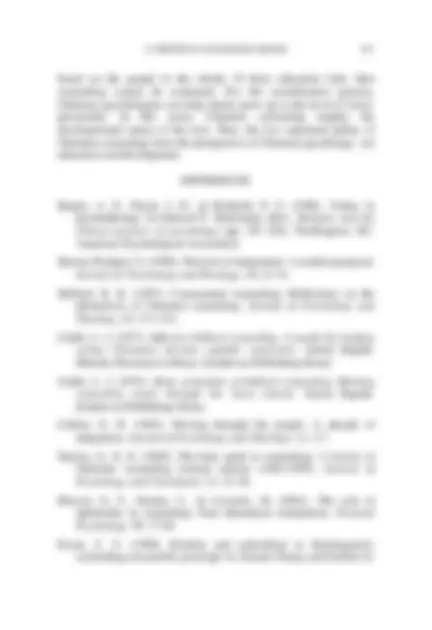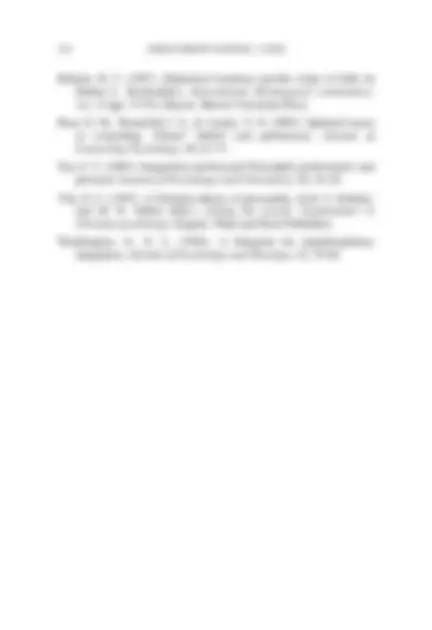












Study with the several resources on Docsity

Earn points by helping other students or get them with a premium plan


Prepare for your exams
Study with the several resources on Docsity

Earn points to download
Earn points by helping other students or get them with a premium plan
Community
Ask the community for help and clear up your study doubts
Discover the best universities in your country according to Docsity users
Free resources
Download our free guides on studying techniques, anxiety management strategies, and thesis advice from Docsity tutors
This paper aims at studying models of Christian counseling.
Typology: Study notes
1 / 18

This page cannot be seen from the preview
Don't miss anything!











A CHRISTIAN COUNSELING MODEL 237
Yong Tae Kim∗
INTRODUCTION
The integration between psychology and Christianity has been a hot issue for Christian counselors since mid 1970s. The movement of integration has been developed in reaction to the acceptance of psychology in the area of pastoral counseling without any criticism about psychology from the Christian viewpoint. Since Jay Adams totally rejected psychology in the area of pastoral care, the effort to integrate psychology with Christianity became so strong during the past two decades. Even though the effort to integrate the two spheres has gained strength, there is a great diversity on how to integrate and what to integrate. Nowadays, diversity seems to be increasing much more rapidly. There are many scholars who want to integrate psychology with Christianity through establishing models of Christian counseling (Hall and Johnson, 2001; Moon, 1997; Bouma-Prediger, 1990; Worthington, 1994; Farnsworth, 1982). There are others who are interested in doing integration through spirituality (Decker, 2002; Moon, 2002; Eliason, Hanley, and Leventis, 2001; Rose, Westefeld, and Ansley, 2001; Howard, McMinn, Bissell, Faries, and VanMeter, 2000; Johnson, 1998, 1997, 1992). There are some scholars who show their interests in integrating various issues of psychology and Christianity (Johnson, 2001; Bufford, 1997; Hall and Hall, 1997). There are other scholars who present their own integration positions between psychology and Christianity (Tan, 2001; Carter and Narramore, 2000; Collins, 1983). Out of the diversity on how to integrate and what to integrate between psychology and Christianity, this paper aims at studying models of Christian counseling. As the writer looked into the existing models of Christian counseling, there are four different models that stand out: level-of-explanation model, integration model, Christian
∗Yong Tae Kim is Associate Professor of Christian Counseling at Torch Trinity Graduate School of Theology.
238 TORCH TRINITY JOURNAL 7 (2004)
psychology model, and biblical counseling model (Johnson, and Jones, 2000). Each model presents a different view about human nature, science and Christianity, personality theories, psychopathologies, and counseling directions. Even though the different models present their own positions, boundaries among the models are not clear. Related issues are not clearly distinctly presented through the models. If boundaries and issues of one model could be presented clearly, then it would be helpful for other models to present their own boundaries and issues. The writer chose the Christian psychology model presented through the following: origin and major figures, psychology and Christianity, theory of personality, major pathologies, and counseling.
ORIGIN AND MAJOR FIGURES
The Christian psychology model originated from three different major proponents, such as Robert C. Roberts, Stephen Evans, and Larry Crabb. Roberts received his B.A. and M.A. from Wichita State University and B.D. and Ph.D. from Yale University. He taught at Wheaton College for a number of years and is currently teaching ethics at Baylor University. His interests are in moral psychology, the psychology of Kierkegaard, and theory of emotion. He has written numerous books and articles in the area of integrating psychology with Christianity while teaching at Wheaton College. Evans received his B.A. from Wheaton College and Ph.D. in Philosophy from Yale University in 1974. He taught philosophy at Calvin College and is currently teaching philosophy at Baylor University. He has written numerous books and articles in the area of existential faith, and historical understanding of Jesus and Kierkegaard. His current concern is to build Christian ethics through the philosophy of Kierkegaard. Crabb received his B.S. in psychology from Ursinus College, and M.A. and Ph.D. in clinical psychology from University of Illinois. He taught psychology at University of Illinois and Florida Atlantic University. After that, he went into private practice for ten years. He taught biblical counseling at Grace Theological Seminary and is currently teaching biblical counseling at Colorado Christian University. He wrote many books in the area of integrating psychology with Christianity in Christian counseling. These scholars are interested in building Christian psychology that will integrate psychology with Christianity. Even though the three
240 TORCH TRINITY JOURNAL 7 (2004)
psychology. Therefore, psychology should adapt itself to the biblical system. Christian psychologists do not define the so-called psychology as already an established discipline. They treat the discipline of psychology as just a contemporary psychological system. It excludes many other types of psychologies in the human history (Roberts, 2000, p. 150). From the point of area of discipline, psychology is still establishing. A very good example is feminist psychology. It is developing a psychological system from feminist point of view. In the same way, Christian psychology is also possible for establishing a new psychological system. From the human history, there have existed many different kinds of psychologies such as Aristotle’s Nichomachean Ethics (fourth century B.C.), theory of emotion developed by Stoic Chrysippus (third century, B. C.), Thomas Aquinas’ Summa Theologiae (thirteenth century, A. D.), the psychological insights about human motivations from the novels by Charles Dickens, George Elliot, Fyodor Dostoyevsky, and Leo Tolstoy (Roberts, 2000, p. 150). These psychologies have been excluded because of the difficulties of scientific study. Christian psychologists want to redefine psychology as a discipline that includes both values and scientific research. Contemporary psychology is narrowly defined only as a scientific way that excludes the value system. But Christian psychologists argue that science cannot be free from the value system even though scientists insist that science is a value-free activity. Jones (1996) points out that science is related with value system from the postpositivistic philosophy of science as follows: theory-laden data, value- laden theory, and scientific progress in conceptual value system (pp. 118-121). Furthermore, science supports a certain value system of objectivism that is contrary to subjective value system. Objectivism is a system of value that supports a certain distance between the observer and the observed object. Actually, human activities cannot be free from values. Based on the postpositivistic philosophy, many scholars are studying integrative points between traditional psychology and religious values (Bergin, Payne, and Richard, 1996, pp. 297-325). Psychology becomes not only observable and proof-laden enterprise but also value-laden system of discipline. There is another question in relation to the task of redefining psychology. Why should it be psychology? Can it be called a different name? Roberts (2001) gives two possible different answers (pp. 134-
A CHRISTIAN COUNSELING MODEL 241
137). One is related to psychological help and the other is the resource of Christian tradition. In the contemporary society, there has been dramatically increased demand for psychological help. Contemporary people experience tremendous psychological difficulties and sufferings. From the Christian tradition, there have been a lot of psychological resources. These could not be deleted from the tradition under the different names. Christian psychologists try to build a new form of psychology through Christian history and biblical tradition. From Christian history, they focus on important Christian figures such as Augustine (studied by Eric L. Johnson), Thomas Aquinas (studied by Richard W. Cross), Richard Baxter (studied by Kenneth L. Roth), Joseph Butler (studied by Mark R. Talbot), George Berkley (studied by James L. Spiegel), John Wesley (studied by H. Newton Malony), and Kierkegaard (studied by Julia Watkin) (Roberts, 2000, p. 154). There are several examples of psychological studies on Christian history as follows: Eric Johnson’s exploration of the history of Christian concept of the soul, Walter Sundberg’s study about “the relationship between suffering and therapy in the thought of such Reformation and Counter Reformation figures as Martin Luther and Ignatius Loyola,” Stephen Evan’s study of Kierkegaard’s psychological methods, and Roberts’ study of moral psychology on Kierkegaard (Roberts, 2000, p. 154). Roberts (2000) suggests two points for studying psychology from Christian tradition (pp. 155-159). The first point is that Christian psychologists want to draw pure psychological insights from Christian tradition without any contamination from contemporary psychological values. Contemporary psychology holds the position of egoistic and individualistic value system that represents on atheistic perspective. The second point is that psychology from Christian tradition should be made available for the contemporary people. The new form of psychology should be translated into the contemporary system of psychology. Biblical content is another important source for the establishment of Christian psychology. Christian psychologists show their interests in biblical passages on the psychology of Jesus Christ and Pauline psychology. Regarding the psychology of Jesus Christ, Roberts (2000) suggests the Sermon on the Mount as the perfect example (pp. 159- 168). Even though the Sermon on the Mount does not include the contemporary psychological terms such as motivation, behavior, thoughts, feelings, etc, it provides very important psychological
A CHRISTIAN COUNSELING MODEL 243
events, intrapsychic elements, or environmental stimuli. Christian personality theory assumes that humans have free will to decide or not to decide. The fourth one is individualism versus interdependence. Secular personality theory assumes that an isolated autonomous self is mature and healthy. Christian one assumes that mutuality or interdependence is mature and healthy. The fifth one is self-centered morality versus morality centered on God and others. Secular psychology assumes that all values belong to an individual person. But Christian psychology assumes that there is absolute moral standard revealed by God. The last one is subjectivism versus realism. Humanistic psychology assumes that humans can know their mind by themselves. Christian psychology assumes that the objective world created by God exists. Humans cannot limit the objective world by subjective feelings and thoughts. Roberts (1997) also criticizes secular theories of personality that pursue individualistic way as healthy and mature (pp. 11-12). He argues that secular psychology promotes such values as individuation (Carl Jung), self-actualization (Carl Rogers), differentiation of self (Murray Bowen), how to love oneself in contrast to co-dependency, how to enhance self-interests (rational emotive therapy), and so on. Secular psychologists emphasize the dysfunctional aspects of dependency, enmeshment, accepting other person’s values and use their therapy to separate people from social connections and networks. Based on the presuppositional critics of the secular theories of personality, Christian psychologists present unique personality theory. Paul Vitz (1997) suggests the Trinitarian model for the theory of personality (pp. 29-40). “The concept of a person was developed to help formulate the doctrine of the Trinity—God as three persons” (Vitz, 1997, p. 30). He distinguishes the concept of “individual” from “person”, criticizing humanistic concept of individual. In the humanistic school, there is no concept of person. On the other hand, Christian psychologists can build a distinguished theory of personality based on the concept of person. He further suggests three overlooked points for the personality theory: traditional values (faith, self-control, patience, humility, hope, and so on), forgiveness, and interdependent relationship. Roberts (1996) divides basic human nature into two different subcategories of basic teleology and basic structure (pp. 77-89). He depicts the basic personality structure through observing biblical
244 TORCH TRINITY JOURNAL 7 (2004)
passages. Humans have a purpose for having personality that is teleology of personality. Humans also have certain characteristics and personality functions that are basic to the structure of personality. The purpose of personality structure is to love God, others, and take care of nature. This is God’s design. In order to fulfill God’s desire, personality has certain characteristics as follows: verbivorousness, agency, inwardness, attachment and self-association, self-dissociation, and permeability. As verbivorous beings, humans can digest God’s words and other things. Digestion means rumination of the words that make humans think objectively. Humans can be spiritual and see or digest objectively. As the second characteristic of human personality, humans are self-determining agents even though humans are bound by intrapsychic personality traits and other environmental factors. When humans can develop themselves, they move from one state to another. The movement and transition is possible because humans are self- determining agents. The third characteristic is inwardness that is called heart or mind in the Bible. Human inwardness includes wishes, motives, thoughts, emotions, intentions, and attitude in general psychology. The inwardness is not easily observable. The fourth characteristic is attachment. Humans are attached to their loved ones. They are not completely independent from others. This gives insights that humans can relate to God and others. The fifth characteristic is self-duplication which is presented by self-association and self-dissociation. Humans can transcend themselves and join in themselves. The last characteristic is permeability that shows humans can be in other humans. Through thoughts, images, and feelings, humans can join in other humans. Roberts (1996) suggests two important points of the personality of Christian psychology (pp. 89-94). One point is the concept of maturity and the other point is development of personality. The Bible presents the ideal form of personality. Traditionally presented traits characterize the ideal form of personality. These are hope, self-control, patience, humility, obedience, holiness, gentleness, hospitality, and so on. Usually, these traits are known to be the fruit of the Holy Spirit. But humans are not perfect and their personalities are also not perfect. Because of this character, the second point comes in. From the imperfect personality to the ideal or perfect personality, humans can grow or develop. The ideal form of personality had been shown through Jesus. He is the perfect example of perfect personality. Humans can develop themselves up to the perfect model of Jesus’ personality.
246 TORCH TRINITY JOURNAL 7 (2004)
experiencing in this world. Sin is an overarching or broad concept to explain human perversions and the failure to come up to the personality trait of God. The Bible presents two different kinds of human nature and trait. One set is love, hope, faith, forgiveness, gentleness, humility, and self-control that belong to the fruit of the Holy Spirit. The other set is doubt, anxiety, pride, self-centeredness, desperateness, anger, and hatred that are called sin. In this way, sin is a concept to represent or explain human pathology. Human pathology comes from four different problem areas: spiritual, relational, ecological, and psychological problems. The first area is spiritual problem that which is related to rebellion against God. Spiritual problems include disobedience, faithlessness, pride, arrogance, self-centeredness, and ingratitude. These problems are surely contrasted with the virtue of obedience to God, such as humility, faith, God- centeredness, and gratitude. Spiritual problems are originated from the refusal to submit oneself to God and the desire to be God. Spiritual problems are based on the narcissistic attitude to have self-lordship. The second area is the relational problem of alienation from fellow humans. This is manifested in unfair competition, envy, jealousy, self- centeredness, grudge bearing, injustice, and favoritism. The biblical prescription for the people in alienation is harmonious relationship, acceptance, approval, justice, fair treatment, and genuine concern for others. Because of alienation from other people, humans want to dominate others and be served by them. The third area is ecological problem. This refers to alienation from nature. This results in greed, insensitivity, partiality, and destruction of the natural ecosystem. The Bible tells that humans should take care of the nature that God entrusted to them and exercise stewardship in terms of his use, development and replication. In other words, human should maintain their harmonious relationship with nature. The last area is psychological problem. This is the intrapsychic alienation from human form the human self. This problem is related to motivational, behavioral, attitudinal, cognitive, and affective area that results in loneliness, anxiety, anger, paranoid thoughts, pride, self-centeredness, shame, etc. The biblical prescription for this problem is self-control, inner peace, trust, humility, confidence, stability, and joy. This problem is also related to the lack of integrity of the human personality. Various positions about human pathology include natural view, universal sin view, and individual sin view. Natural view means that
A CHRISTIAN COUNSELING MODEL 247
human pathology is natural and exists beyond moral judgment. Some scholars who adhere to the natural view see human pathology as a disease. When human pathology is considered as a disease, humans are not totally responsible for their own pathology. One example of the disease model is alcoholic problem. Scholars subscribing to this disease model insist that the problem of alcoholics originated from genetic disorder. In contrast, scholars advocating the sin view see human pathology as originating from the ‘humans’ wrong treatment whether it is corporate or individual. Therefore, humans are not exempt from the pathology and should be responsible. The universal sin view means that human pathology is originated from the corporate sins of humans. Corporate sin includes the structural dysfunction of human societal system and necessary evils that cannot be rooted out from human society. Universal sin refers to the fundamental human sins that cannot be completely rooted out from humans. The examples of the universal sin are human organizations, human body, etc. The individual sin view holds that human pathology originated from individual conscious behaviors. In this view, human pathology comes from the conscious behaviors that humans are committing. Therefore, human pathology is individual and collective responsibility. Christian psychologists hold the view of sin in regard to human pathology. They put an emphasis on individual responsibility even though they accept a little bit of the universal sin view. Roberts (1997) says, “In light of our nature as agents, we explain sin by saying that we choose it, we did it, and thus corrupted ourselves by our own actions. We are responsible for our own dysfunction.” (p. 95). Larry Crabb (1975) also insists that pathology comes from the wrong beliefs lodged deep in human mind. In his aerial view of human problems, he presents a model of change and teaches sound concepts about human pathology. He suggests the need to identify negative feelings, behaviors, and serious thinking about sin. Negative thinking comes from sinful nature. Negative thinking should be changed to right thinking that comes from God or taught in the Bible. Even though Christian psychologists put an emphasis on individual responsibility, they still admit the universal sin concept. Roberts (1997) limits the universal sin in the extreme cases of human pathology. He says, “In extreme cases the personality may be so damaged at this early stage that the individual lacks the motivational or perceptional resources for significant moral agency….making it more likely that we
A CHRISTIAN COUNSELING MODEL 249
is to initiate the remedial process of restoring the human personality into original state in the Garden of Eden. Counseling according to the Christian psychology model can be divided into two different activities. The first one is evangelism as a counseling activity. In order to do this, education and challenge are the most important intervention strategies. If a client does not have any idea of who God is and what Jesus Christ did for sinful humanity, then a counselor should teach him or her the basic concepts of what Christianity is about. After teaching the basic concepts of Christianity, the counselor guides the client to accept Jesus Christ as his/her Savior. In case of refusal to accept Jesus as Lord, then the counselor can use the intervention strategy of challenge or confrontation. If the confrontation or challenge fails, then counseling ends. The second one is sanctification as another counseling activity. In this case, Roberts explains, counseling consists of “strategies for encouraging the patient to associate himself with this better self and dissociate himself from what is dysfunctional in him” (1997, p. 98). In other words, counseling intervention is to encourage the client to fight against the sinful nature or dysfunctions and to promote Christian virtues. For this purpose, Christian counselors could borrow different kinds of techniques from already developed secular theories such as cognitive school, psychodynamic school, humanistic school, and family school. In this sense, Christian psychology model accepts some concepts and techniques from secular counseling theories. Larry Crabb (1975) states this point clearly as follows: “I strongly object to counselors who in the name of Scripture deny Rogers any hearing whatsoever.... The problem with Rogers is less with what he does and more with what he does not do.” (p. 77). In the counseling process, Christian psychologists could utilize the eclectic approach in adapting various techniques from different theories and positions. Larry Crabb (1977) suggests a model of Christian counseling. He also suggests levels and stages of counseling. These levels of counseling include: problem feelings, problem behaviors, and problem thinking. The first level is related to problem feelings. In order to deal with this problem, encouragement is necessary. Through encouragement, problem feelings should be changed into biblical feelings. The second level is problem behavior. In order to change the problem behavior, exhortation is necessary in the process of counseling. Through exhortation, problem behavior could be changed into biblical
250 TORCH TRINITY JOURNAL 7 (2004)
behavior. The third level is problem thinking. In order to change problem thinking, enlightenment is necessary in the counseling process. If the client is enlightened, then he/she will think biblically. In terms of counseling stages, Crab suggests seven different steps: identifying problem feelings, identifying problem behaviors, identifying problem thinking, clarifying biblical thinking, securing commitment, planning and carrying out biblical behaviors, and identifying spirit-controlled feelings.
CONCLUSION
Christian psychology has a prescriptive approach to the understanding of personality in contrast to the secular psychology that is descriptive in nature. Prescriptive approach means that there is an absolute standard to the state of personality. Descriptive approach means that human nature can be described through objective observation. Secular counseling theories are based on how the human nature is observed and described. But Christian psychology is based on the absolute biblical standard that is given through the Bible. Christian psychology tries to find the absolute criteria through the Bible and Christian history. Many Christian psychologists make effort to find psychologies of the great historical figures like Thomas Aquinas, Kierkegaard, Charles Dickens, Leo Tolstoy, etc. Among the many great figures, Kierkegaard is the most highlighted person to study. He was described as a developmental or a moral psychologist. In the Bible, the psychology of Jesus was also highlighted among the Christian psychologists. The psychology of Jesus was well presented through the Sermon on the Mount. Pauline psychology also was highlighted. In Pauline psychology, two different selves, the old and new were emphasized. Pathology is related to the absolute standard of personality. The characteristics of falling short of the standard are pathological symptoms. Basically, human personality comes from the separation from God, fellow humans, nature, and self. God’s redemptive action is exactly the remedial process of human pathology. God has provided us the absolute example for counseling process. Jesus is the center of this remedial process for restoration. Therefore, counseling has two different stages: evangelism and sanctification. In evangelism, Christian psychologists should teach the basic theory of personality
252 TORCH TRINITY JOURNAL 7 (2004)
Marino The Cambridge companion to Kierkegaard (pp. 154-176). Cambridge University Press.
Evans, C. S. (1990). Soren Kierkegaard’s Christian psychology: Insight for counseling and pastoral care. Vancouver: Regent College Publishing.
Farnsworth, K. E. (1982). The conduct of integration. Journal of Psychology and Theology , 10, 308-319.
Hall, M. E. L., & Johnson E. (2001). Theodicy and Therapy: Philosophical/theological contributions to the problem of suffering. Journal of Psychology and Theology , 20, 5-17.
Hall, M. E., & Hall, T. W. (1997). Integration in the therapy room: An overview of the literature. Journal of Psychology and Theology , 25, 86-101.
Howard, N. C., McMinn, M. R., Bissell, L. D., Faries, S. R., & VanMeter, J. B. (2000). Spiritual directors and clinical psychologists: A comparison of mental health and spiritual values. Journal of Psychology and Theology , 28, 308-320.
Johnson, E. L. (1998). Whatever happened human soul? A brief Christian genealogy of a psychological term. Journal of Psychology and Theology , 26, 16-28.
Johnson, E. L., & Jones, S. (2000). Psychology & Chrisitianity with contributions by Gary R. Collins, David G. Myers, David Powlison, Robert C. Roberts. Downers Grove: Inter Varsity Press.
Johnson, E. L. (1997). Christ, the lord of psychology. Journal of Psychology and Theology , 25, 11-27.
Johnson, E. L. (1992). A place for the Bible within psychological science. Journal of Psychology and Theology , 20, 346-355.
Johnson, S. (2001). One step closer: The implicit use of Scripture in counseling. Journal of Psychology and Christianity. 20, 91-94.
Jones, S. L. (1996). A constructive relationship with the science and profession of psychology: Perhaps the boldest model yet. In Edward P. Shafranske (Ed.), Religion and the clinical practice of psychology (pp. 297-326). Washington, DC: American Psychological Association.
A CHRISTIAN COUNSELING MODEL 253
Moon, G. W. (2002). Christian spirituality and mental health: Introducing a new section of the journal. Journal of Psychology and Christianity , 21, 62-63.
Moon, G. W. (1997). Training tomorrow’s integrators in today’s busy intersection: Better look four ways before crossing. Journal of Psychology and Theology , 25, 284-293.
Narramore, S. B., & Carter, J. D. (2000). On straw men, autonomous spheres, and the integration of psychology and theology: A reply to Cole. Journal of Psychology and Theology , 19, 71-77.
Roberts, R. C. (2001). Outline of Pauline psychotherapy. In Mark R. McMinn and Timothy R. Phillips (Eds.), Care for the soul: Exploring the intersection of psychology & theology. Downers Grove: InterVarsity Press.
Roberts, R. C. (2000). A Christian Response. In Eric L. Johnson and Stanton L. Jones (Eds.), Psychology & Chrisitianity with contributions by Gary R. Collins, David G. Myers, David Powlison, Robert C. Roberts (pp. 135-140). Downers Grove: InterVarsity Press.
Roberts, R. C. (2000). A Christian psychology view. In Eric L. Johnson and Stanton L. Jones (Eds.), Psychology & Chrisitianity with contributions by Gary R. Collins, David G. Myers, David Powlison, Robert C. Roberts (pp. 148-177). Downers Grove: InterVarsity Press.
Roberts, R. C. (1998). Existence, emotion, and virtue: Classical themes in Kierkegaard. In Alastair Hanny and Gordon D. Marino (Eds.), The Cambridge companion to Kierkegaard (pp. 154-176). Cambridge University Press.
Roberts, R. C. (1997). Parameters of a Christian psychology. In R. C. Roberts, and M. R. Talbot (Eds.), Liming the psyche: Explorations in Christian psychology. Eugene: Wipf and Stock Publishers.
Roberts, R. C. (1997). Introduction: Christian psychology? In R. C. Roberts, and M. R. Talbot (Eds.), Liming the psyche: Explorations in Christian psychology. Eugene: Wipf and Stock Publishers.